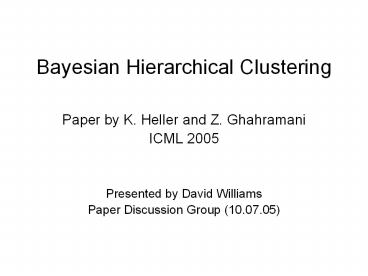Bayesian%20Hierarchical%20Clustering - PowerPoint PPT Presentation
Title:
Bayesian%20Hierarchical%20Clustering
Description:
... used to decide which merges are advantageous, and to decide appropriate depth of tree. Algorithm can be interpreted as approximate inference method for a DPM; ... – PowerPoint PPT presentation
Number of Views:151
Avg rating:3.0/5.0
Title: Bayesian%20Hierarchical%20Clustering
1
Bayesian Hierarchical Clustering
- Paper by K. Heller and Z. Ghahramani
- ICML 2005
- Presented by David Williams
- Paper Discussion Group (10.07.05)
2
Outline
- Traditional Hierarchical Clustering
- Bayesian Hierarchical Clustering
- Algorithm
- Results
- Potential Application
3
Hierarchical Clustering
- Given a set of data points, output is a tree
- Leaves are the data points
- Internal nodes are nested clusters
- Examples
- Evolutionary tree of living organisms
- Internet newsgroups
- Newswire documents
4
Traditional Hierarchical Clustering
- Bottom-up agglomerative algorithm
- Begin with each data point in own cluster
- Iteratively merge two closest clusters
- Stop when have single cluster
- Closeness based on given distance measure (e.g.,
Euclidean distance between cluster means) - Limitations
- No guide to choosing correct number of
clusters, or where to prune tree - Distance metric selection (especially for data
such as images or sequences) - How to evaluate how good result is, how to
compare to other models, how to make predictions
and cluster new data with existing hierarchy
5
Bayesian Hierarchical Clustering (BHC)
- Basic idea
- Use marginal likelihoods to decide which clusters
to merge - Asks what the probability is that all the data in
a potential merge were generated from the same
mixture component. Compare to exponentially many
hypotheses at lower levels of the tree - Generative model used is a Dirichlet Process
Mixture Model (DPM)
6
BHC Algorithm Overview
- One-pass, bottom-up method
- Initializes each data point in own cluster, and
iteratively merges pairs of clusters - Uses a statistical hypothesis test to choose
which clusters to merge - At each stage, algorithm considers merging all
pairs of existing trees
7
BHC Algorithm Merging
- Two hypotheses compared
- 1. all data in the pair of trees to be merged was
generated i.i.d. from the same probabilistic
model with unknown parameters (e.g., a
Gaussian) - 2. said data has two or more clusters in it
8
Hypothesis H1
- Probability of the data under H1
- Prior over the parameters
- Dk is the data in the two trees to be merged
- Integral is tractable when conjugate prior
employed
9
Hypothesis H2
- Probability of the data under H2
- Is a product over sub-trees
- Prior that all points belong to one cluster
- Probability of the data in tree Tk
10
Merging Clusters
- From Bayes Rule, the posterior probability of the
merged hypothesis - The pair of trees with highest probability are
merged - Natural place to cut the final tree where
11
Dirichlet Process Mixture Models (DPMs)
- Probability of a new data point belonging to a
cluster is proportional to the number of points
already in that cluster - a controls the probability of the new point
creating a new cluster
12
Merged Hypothesis Prior
- DPM with a defines a prior on all partitions of
the nk data points in Dk - Prior on merged hypothesis, pk, is the relative
mass of all nk points belonging to one cluster
versus all other partitions of those nk points,
consistent with the tree structure.
13
DPM
- Other quantities needed for the posterior merged
hypothesis probabilities can also be written and
computed with the DPM (see math/proofs in paper)
14
Results
- Some sample results
15
(No Transcript)
16
(No Transcript)
17
Unique Aspects of Algorithm
- Is a hierarchical way of organizing nested
clusters, not a hierarchical generative model - Is derived from DPMs
- Hypothesis test is not for one vs. two clusters
at each stage (is one vs. many other clusterings) - Is not iterative and does not require sampling
18
Summary
- Defines probabilistic model of data, can compute
probability of new data point belonging to any
cluster in tree. - Model-based criterion to decide on merging
clusters. - Bayesian hypothesis testing used to decide which
merges are advantageous, and to decide
appropriate depth of tree. - Algorithm can be interpreted as approximate
inference method for a DPM gives new lower bound
on marginal likelihood by summing over
exponentially many clusterings of the data.
19
Why This Paper?
- Mixed-type data problems both continuous and
discrete features - How to perform density estimation?
- One way partition continuous data into groups
determined by the values of the discrete
features. - Problem number of groups grows quickly. (e.g., 5
features, each of which can take 4 values, gives
451024 groups) - How to determine which groups should be combined
to reduce the total number of groups? - Possible solution idea in this paper, except
rather than leaves being individual data points,
they would be groups of data points as determined
by the discrete feature-values































